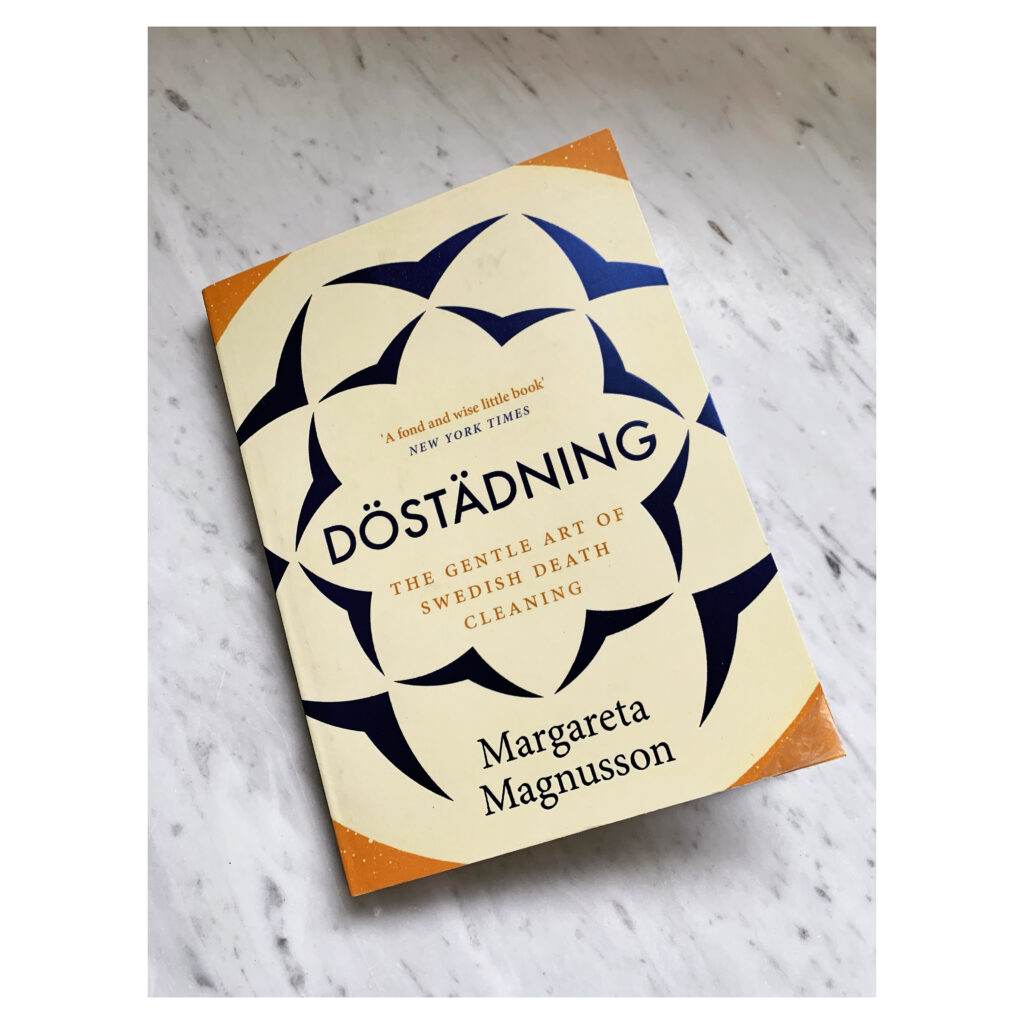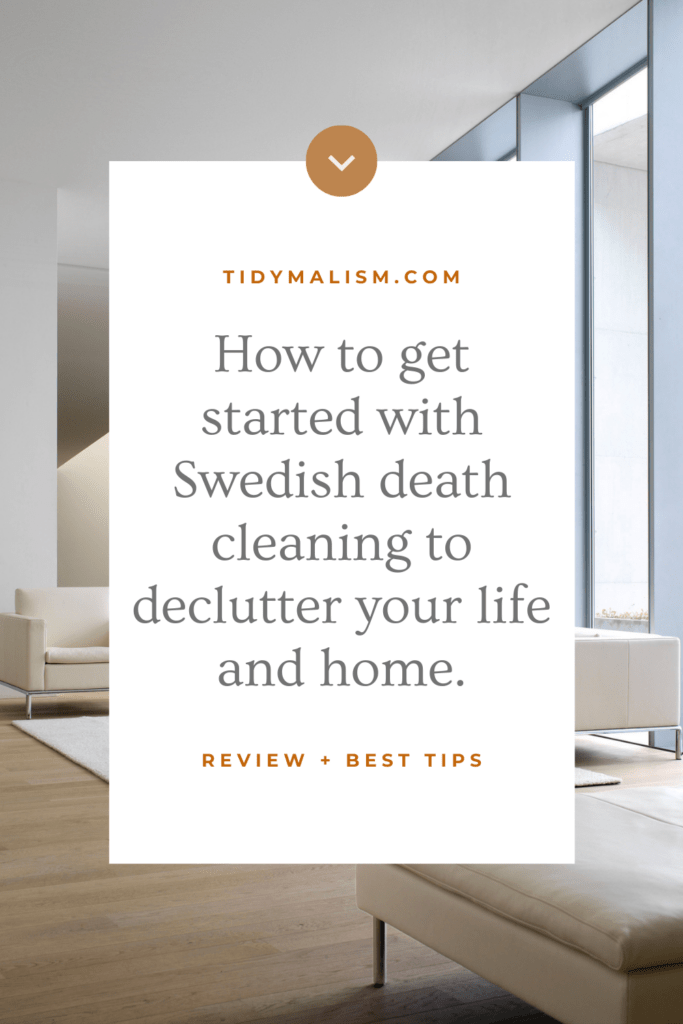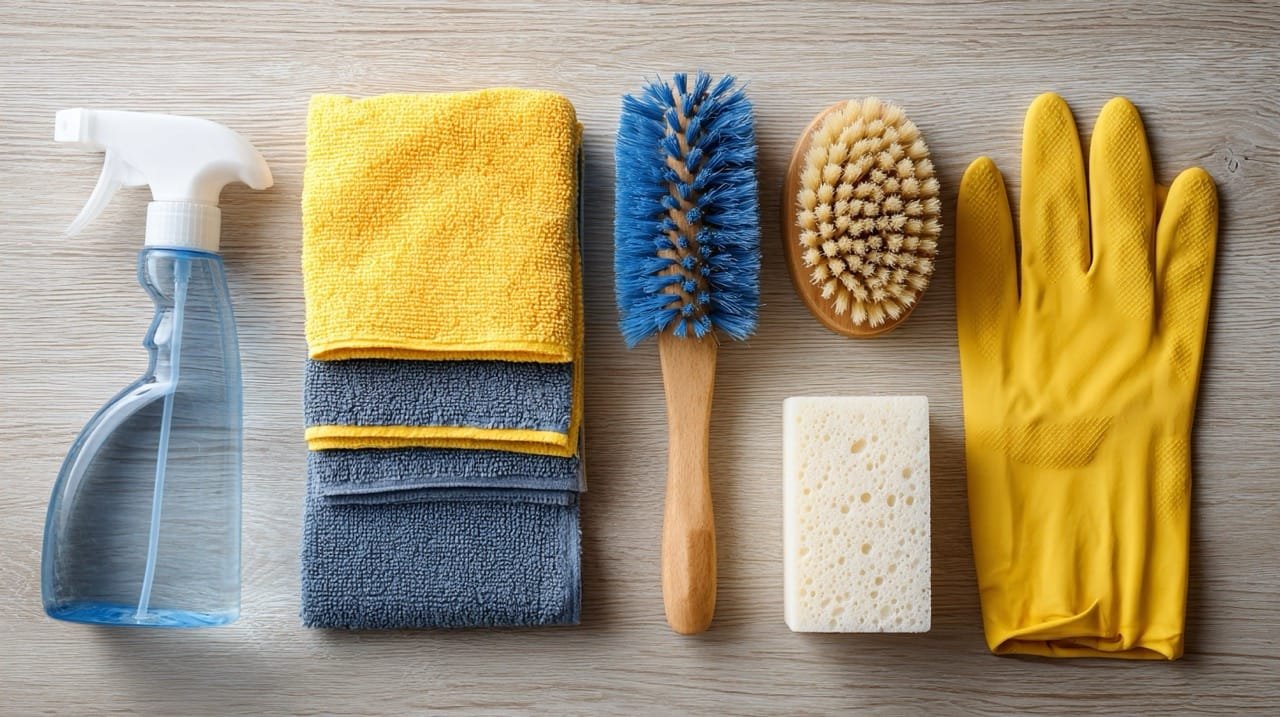A bit late to the game of Scandinavian tidying trends, I picked up a copy this week of Margareta Magnusson‘s book, Döstädning. The Gentle Art of Swedish Death Cleaning. It’s a modest volume of just 127 pages written in simple language, and thus a quick read.
Is it worth reading? Yes. It has its charm and is full of colourful, personal anecdotes. The author is, as she says in various chapters, “somewhere between eighty and one hundred years old.” She’s lived a full life in places outside of Sweden such as Singapore and the US. She has some touching stories to tell, and even shares a few recipes along the way.
Does Mrs Magnusson reinvent the home organisation wheel? No. Some reviewers on Amazon were disappointed that no explicit deluttering checklists were offered up in this book. That was not its point, however. Read on!
Table of Contents
What the Heck Is Swedish Death Cleaning?
“Death cleaning is not about dusting or mopping up; it is a permanent form of organisation that makes your everyday life run more smoothly.”
Swedish death cleaning feels to me like the polar opposite of the Konmari method of decluttering. Marie Kondo’s all-out approach of dumping all your belongings on the floor and making a gargantuan mess will truly disrupt your life and household for days (if not weeks), while death cleaning is gentle and slow. It’s done incrementally, and thoughtfully, over time, in preparation for what awaits us all: dö, death in Swedish, is our universal, inevitable fate.
That’s neither morbid, nor sad; our mortality is a fact of life. We must all talk about death, as the author says. Another truth – and this is the motivation behind the book – is that when you die, you leave a lot of stuff behind if you have not death cleaned. Stuff that nobody wants. Stuff that other people will carry the burden of dealing with when you’re gone.
“Some people can’t wrap their heads around death. And these people leave a mess after them. Did they think they were immortal?”
Döstädning is about cleaning up before yourself – before you die.
Death Cleaning Is Not Just About You
Confronted with the deaths of her own parents, and later her husband, Mrs Magnusson set upon städning, or cleaning up after they passed. Her book aims to “make your loved ones’ memories of you affectionate, rather than upsetting” when you’re gone.
Going through someone’s things and household after they pass away is heart wrenching enough without the additional burden of having to deal with decades’ worth of amassed clutter or awkward items.
Swedish death cleaning, in such, is not just something you do for yourself to have an organised home or live more minimally. It’s done out of love and respect for the people who come to clean up after your death.
“Do not ever imagine that anyone will wish – or be able – to schedule time off to take care of what you didn’t bother to take care of yourself. No matter how much they love you, don’t leave this burden to them.”
When to Start Swedish Death Cleaning
Death cleaning can be done at any age, for example when you are in your thirties and decide your closet is overflowing with things you never wear. In its true intent and purpose, however, the objective of döstädning is to make your estate manageable before you take off to the great beyond. It’s about making your life simpler, and living smaller.
Mrs Magnusson recommends starting the process in the second half of middle age. This makes it easy to be prepared to downsize your home later on when you go into retirement. You might want to move from a house to a flat, or perhaps in advanced age you’ll have the need to relocate to a nursing home or elderly community. It is better to clear your things out and organise everything while you are still fit and have energy.

Some Personal Notes
Reading The Gentle Art of Swedish Death Cleaning, it seemed a funny coincidence to me that this is precisely what I unknowingly embarked on myself with my recent bursts of decluttering, and how I came to start Tidymalism in the first place. In recent months I had become ever more acutely aware for the first time in my life that I, too, will die one day. That well over half of my life is already over. I chalked it up to the impending trepidation I felt as a big birthday loomed close on the horizon.
Months before that birthday, I could not shake the sense that I was slowly suffocating in stuff. There is so much to prepare, and so much to declutter. I thought of an older couple I know who are trapped in a house with 11 rooms that has outgrown them, the monthly mortgage payments for which are an immense financial strain. The only reason they say they cannot move is that they do not know where to start decluttering, or how. All of their 11 rooms are full to the brim, along with their garage and pantries and closets. I have vowed to myself not to wind up in a situation like that when I’m in my seventies.
I thought of my grandmother, too, who always gave my siblings very random items from her household each time they visited. Now I understand why, and what she was very purposefully preparing for. She will be 101 years old this year, and only just moved to a nursing home a few years ago. She prepared her downsizing for many years, and she now she enjoys her iPad instead of her book collection.
How to Do Death Cleaning

There is neither a timeframe, nor a checklist for doing döstädning provided in The Gentle Art of Swedish Death Cleaning. The process can, and likely will, take a few years. Perhaps as I advance over the coming year or so with my own death cleaning, I shall take that on as the subject of a longer blog post or series.
In place of a straightforward guide, Mrs Magnusson provides anecdotal information on how to assess various categories of possessions. From clothing and overflowing cupboards full of china, to old letters and even sex toys, it’s all here.
She astutely advises that you should never start by decluttering photographs or anything of sentimental value. Such possessions will quickly suck you into the past which is both intensely emotional and time-consuming. Instead, she knowledgeably advises starting with the cellar, attic, and storage units at the front door. These areas often contain a conglomerate of old junk we’ve forgotten about, which can be disposed of. In turn, freeing up these areas provides you space to temporarily park items you’ve weeded out to give away.
She also recommends generally beginning with simpler things like clothing, and larger items such as furniture. If you’re already set on downsizing, you can begin the process of selling off these items or giving them away. Additionally, informing family members, friends and neighbours of what you’re up to is a good idea she says. Sometimes someone in your immediate circle will want your books, kitchen items or furniture. This saves you the time and trouble of trying to sell them or having to cart them away.
Key Takeaways
My biggest takeaways from this little book were from the realm of personal possessions. In particular, I found Mrs Magnusson’s suggestion of creating a “Throw Away Box” immensely useful, and plan on doing this.
This box holds the things you feel you absolutely cannot part with, yet have no use or meaning to others. They might even be very private possessions. Love letters, mementos from travelling, a special stone or seashell you found on an equally special day, a newspaper clipping about a past lover who went on to become a famous musician. Things dear to your heart.
You can label it “Private! Throw away!” so your people know what to do with it when you are gone.
Another tip the author gives us revolves around decluttering secret, dangerous, or hidden things. In essence, she says that if it was a secret whilst you were alive, it should ideally remain a secret after your parting.
“There’s no sense in keeping things that will shock or upset your family after you are gone.” Documents or diaries containing hurtful or embarrassing information should, she goes on, be burnt or shredded. And you should reduce the number of items of a more intimate nature.
“So save your favourite dildo, but throw away the other fifteen!”
More generally speaking, I also appreciated the author’s advice on making notes as to what should be done with certain belongings after death. I maintain an inventory tracker for my household and plan on attaching such notes to that for all the special items not specifically indicated in a testament.
Critique
What I sorely missed throughout the entire book was some sort of acknowledgement of single people like me who have no family, no partner, and live alone. Towards the very end, on page 117, the author mentions child-free people for the first time, saying that they still must death clean and sort out their lives, as their possessions will burden someone who has to pick up after them.
I wish she had included us all along in the book, yet it read as if she assumed that all readers have family and children they can pass their decluttered belongings on to, or ask for help from.
There was also one chapter which I found sad. Titled “Pets,” it came in between the chapters about tidying up the garden supplies and decluttering photographs. Beloved pets are not clutter, however. They are family members and loyal companions.
This might be a generational difference; I recall my own parents had similar views of animals. Mrs Magnusson relays how, during her moves abroad, she gave away the family dogs and even had one put down. She explains this was to save them from the four months of quarantine they would have had to endure upon entering Sweden.
It made me wonder why someone would get pets in the first place when they are frequently moving around abroad. Pets are not household appliances, temporary companions, or decorative objects.
Döstädning in Summary
Death cleaning benefits offer a slower, indeed more gentler approach to getting a grip on your stuff. This approach aligns with the current minimalism trend, yet it’s geared to a mature crowd who wants to start getting their affairs in order at a slow and steady pace.
I’ll continue doing my regular bursts of decluttering, but I’m taking the idea of death cleaning as my north star. I realise, too, that there is plenty to prepare apart from the household for later on: a legal testament, management of digital assets and accounts, and logistical things like making sure someone knows the codes to get into my place.
Perhaps I should just look for a younger husband who will outlive me, but I digress.
In conclusion, I can recommend this book, and it gave me a few new ideas. It also helped me better understand my own motivation behind my decluttering and household organisation.
In my region the book was, unfortunately, not available on the Kindle, so I purchased the paperback. (Our libraries do not have much English literature.) If you’re able, borrow it from your local library or try to get the e-book so you’ll have one less book to declutter later on.
Let me know in the comments if you’ve also read the book, and what you thought of it!
Update: Looking for the missing Swedish death cleaning checklist? I put one together for myself since reading the book, and share it with you here.






Leave a Reply